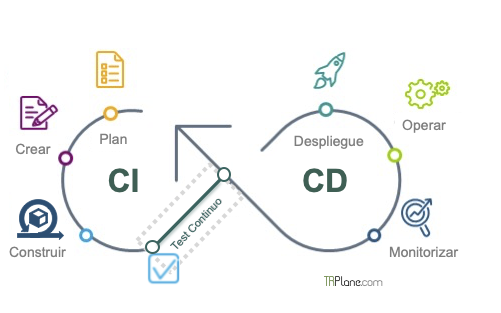Inteligencia Artificial
La integración continua (continuous integration) y la entrega continua (continuous delivery/continuous deployment), también es conocida de forma abreviada como CI / CD. En términos muy simples, CI es una práctica moderna de desarrollo de software en la que los cambios de código incrementales se realizan con frecuencia y de manera segura. Los pasos automatizados de compilación y pruebas realizados en CI garantizan que los cambios de código que se fusionan en el repositorio general sean fiables. Posteriormente, el código se entrega de forma rápida y sin problemas como parte del proceso del CD.
En el mundo del software, la relación entre CI / CD se refiere a la automatización del proceso que permite que los cambios de código incrementales desde los entornos de los desarrolladores se entreguen de manera rápida y fiable a la producción.
¿Por qué es importante CI / CD?
CI / CD permite a las organizaciones construir y poner en producción productos y servicios de forma rápida y eficiente. CI / CD facilita un proceso eficaz para llevar las soluciones al mercado más rápido que nunca, entregando código contínuamente en producción y asegurando un flujo continuo de nuevas funciones y correcciones de errores a través del método de entrega más eficiente.
¿Cuál es la diferencia entre CI y CD?
La integración continua (CI) es una práctica que implica que los desarrolladores puedan realizar en entornos comlaborativos pequeños cambios y verificaciones en su código. Debido a la escala de requisitos y la cantidad de pasos involucrados, este proceso está automatizado para garantizar que los equipos puedan construir, probar y empaquetar sus aplicaciones de una manera fiable y repetible. CI ayuda a simplificar los cambios de código, lo que aumenta el tiempo para que los desarrolladores realicen cambios y contribuyan a mejorar el software.
La entrega continua (CD) es la entrega automatizada de código completo a entornos como pruebas y desarrollo. CD proporciona una forma automatizada y coherente para que el código se envíe a estos entornos.
La implementación continua es el siguiente paso de la entrega continua. Cada cambio que pasa las pruebas automatizadas se coloca automáticamente en producción, lo que resulta en muchas implementaciones o pases a producción en cortos periodos de tiempo.
La implementación continua debe ser el objetivo de la mayoría de las organizacioners que no están limitadas por requisitos reguladores o de otro tipo de terceros organismos.
En resumen, CI es un conjunto de prácticas realizadas durante el proceso de escritura de código de los desarrolladores, y CD es un conjunto de prácticas realizadas después de que se completa el código.

¿Cómo se relaciona CI / CD con DevOps?
DevOps es un conjunto de prácticas y herramientas diseñadas para aumentar la capacidad de una organización para entregar aplicaciones y servicios más rápido que aplicando los procesos de desarrollo de software tradicionales.
La mayor velocidad de DevOps ayuda a una organización a atender a sus clientes con más éxito y ser más competitiva en el mercado.
Una práctica clave consiste en integrar la seguridad (DevSecOps) en todos los flujos de trabajo de DevOps. Al realizar actividades de seguridad de manera temprana y consistente a lo largo del ciclo de vida del desarrollo de software (SDLC), las organizaciones pueden asegurarse de detectar las vulnerabilidades lo antes posible y de poder tomar decisiones informadas sobre el riesgo y la mitigación.
En las prácticas de seguridad más tradicionales, la seguridad no se aborda hasta la etapa de producción, que ya no es compatible con el enfoque DevOps más rápido y ágil. Hoy en día, las herramientas de seguridad deben encajar perfectamente en el flujo de trabajo del desarrollador y la canalización de CI / CD para mantenerse al día con DevOps y no ralentizar la velocidad de desarrollo.
Los circuitos de CI / CD encajan dentro del marco más amplio de DevOps / DevSecOps. Para implementar y ejecutar con éxito una canalización de CI / CD, las organizaciones necesitan herramientas para evitar puntos de fricción que ralentizan la integración y la entrega. Los equipos requieren una serie de herramientas integradas para facilitar los esfuerzos de desarrollo colaborativos y sin obstáculos.
La integración de las herramientas adecuadas en el momento adecuado reduce la fricción general de DevSecOps, aumenta la velocidad de entrega y mejora la calidad y la eficiencia.
Beneficios de CI / CD
- Las pruebas automatizadas permiten la entrega continua, lo que garantiza la calidad y la seguridad del software y aumenta la rentabilidad en el proceso de desarrollo hasta la producción.
- Los circuitos de CI / CD permiten un tiempo de comercialización mucho más corto para las nuevas características de los productos, creando más clientes satisfechos y reduciendo la tensión en el desarrollo.
- El gran aumento en la velocidad de entrega que permiten los circuitos CI / CD mejora la ventaja competitiva de una organización.
- La automatización libera a los miembros del equipo para que se concentren en lo que tienen más experiencia y realizan mejor, lo que produce mejores productos finales.
- Las organizaciones con una cartera de proyectos de CI / CD de éxito pueden atraer grandes talentos. Al alejarse de los métodos tradicionales waterfall, los ingenieros y desarrolladores ya no están atascados con actividades repetitivas que a menudo dependen en gran medida de la realización de otras tareas.

